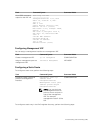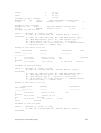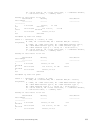
0/0 00:20:19
Dell#
Route Leaking VRFs
Static routes can be used to redistribute routes between non-default to default/non-default VRF and
vice-versa.
You can configure route leaking between two VRFs using the following command: ip route vrf
x.x.x.x s.s.s.s nh.nh.nh.nh vrf default.
This command indicates that packets that are destined to x.x.x.x/s.s.s.s are reachable through
nh.nh.nh.nh in the default VRF table. Meaning, the routes to x.x.x.x/s.s.s.s are leaked from the
default VRF routing table into the non-default VRF routing table.
The following example illustrates how route leaking between two VRFs can be performed:
interface TenGigabitEthernet 1/9
ip vrf forwarding VRF1
ip address 120.0.0.1/24
interface TenGigabitEthernet 1/10
ip vrf forwarding VRF2
ip address 140.0.0.1/24
ip route vrf VRF1 20.0.0.0/16 140.0.0.2 vrf VRF2
ip route vrf VRF2 40.0.0.0/16 120.0.0.2 vrf VRF1
Dynamic Route Leaking
Route Leaking is a powerful feature that enables communication between isolated (virtual) routing
domains by segregating and sharing a set of services such as VOIP, Video, and so on that are available on
one routing domain with other virtual domains. Inter-VRF Route Leaking enables a VRF to leak or export
routes that are present in its RTM to one or more VRFs.
Previous FTOS releases support static route leaking, which enables route leaking through static
commands. Dynamic Route Leaking, introduced in the 9.7(0.0) release, enables a source VRF to share
both its connected routes as well as dynamically learnt routes from various protocols, such as ISIS, OSPF,
BGP, and so on, with other default or non-default VRFs.
You can also leak global routes to be made available to VRFs. As the global RTM usually contains a large
pool of routes, when the destination VRF imports global routes, these routes will be duplicated into the
VRF's RTM. As a result, it is mandatory to use route-maps to filter out leaked routes while sharing global
routes with VRFs.
Configuring Route Leaking without Filtering Criteria
You can use the ip route-export tag command to export all the IPv4 routes corresponding to a
source VRF. For leaking IPv6 routes, use the ipv6 route-export tag command. This action exposes
source VRF's routes (IPv4 or IPv6 depending on the command that you use) to various other VRFs. The
destinations or target VRFs then import these IPv4 or IPv6 routes using the
ip route-import tag or
the ipv6 route-import tag command respectively.
NOTE: In Dell Networking OS, you can configure at most one route-export per VRF as only one set
of routes can be exposed for leaking. However, you can configure multiple route-import targets
because a VRF can accept routes from multiple VRFs.
936
Virtual Routing and Forwarding (VRF)


















